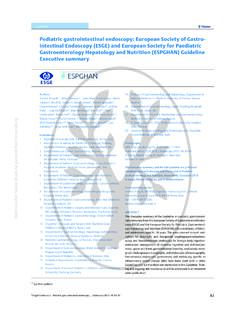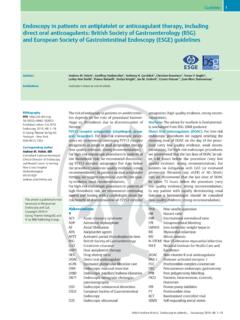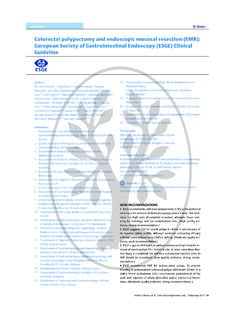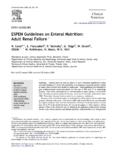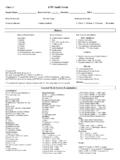Transcription of Endoscopic diagnosis and management of nonvariceal upper ...
1 Endoscopic diagnosis and management of nonvariceal uppergastrointestinal hemorrhage (NVUGIH): European Societyof Gastrointestinal Endoscopy (ESGE) Guideline Update 2021 AuthorsIan M. Gralnek1,2, , A. John Morris3, Marine Camus4,JamesLau5,AngelLanas6, ,Franco Radaelli8, Ioannis S. Papanikolaou9, Tiago C rdia Gon alves10,11,12,MarioDinis-Ribeiro13,14,Ha limAwadie1,Georg Braun15, Nicolette de Groot16, Marianne Udd17, Andres Sanchez-Yague18,19,ZivNeeman2,20, 1 Institute of Gastroenterology and Hepatology, EmekMedical Center, Afula, Israel 2 Rappaport Faculty of Medicine, Technion-IsraelInstitute of Technology, Haifa, Israel 3 Department of Gastroenterology, Glasgow RoyalInfirmary, Glasgow, UK 4 Sorbonne University, Endoscopic Unit, Saint AntoineHospital Assistance Publique Hopitaux de Paris, Paris,France 5 Department of Surgery, Prince of Wales Hospital, TheChinese University of Hong Kong, Hong Kong SAR,China 6 Digestive Disease Services, University Clinic Hospital,University of Zaragoza, IIS Arag n (CIBERehd)
2 , Spain 7 Department of Gastroenterology, Odense UniversityHospital, Odense, Denmark 8 Department of Gastroenterology, Valduce Hospital,Como, Italy 9 Hepatogastroenterology Unit, Second Department ofInternal Medicine Propaedeutic, Medical School,National and Kapodistrian University of Athens, AttikonUniversity General Hospital, Athens, Greece10 Gastroenterology Department, Hospital da Senhora daOliveira, Guimar es, Portugal11 School of Medicine, University of Minho, Braga/Guimar es, Portugal12 ICVS/3B s PT Government Associate Laboratory,Braga/Guimar es, Portugal13 Center for Research in Health Technologies andInformation Systems (CINTESIS), Faculty of Medicine,Porto, Portugal14 Gastroenterology Department, Portuguese OncologyInstitute of Porto, Portugal15 Medizinische Klinik 3, Universit tsklinikum Augsburg,Augsburg, Red Cross Hospital Beverwijk, Beverwijk, TheNetherlands17 Gastroenterological Surgery, University of Helsinki andHelsinki University Hospital, Helsinki, Finland18 Gastroenterology Unit, Hospital Costa del Sol,Marbella, Spain19 Gastroenterology Department, Vithas XanitInternational Hospital, Benalmadena, Spain20 Diagnostic Imaging and Nuclear Medicine Institute,Emek Medical Center, Afula, Israel21 Department of Gastroenterology and Hepatology,Leiden University Medical Center, Leiden, TheNetherlandspublished online 2021; 53: 300 332 DOI 0013-726X 2021.
3 European Society of Gastrointestinal Endoscopy All rights article ist published by Thieme Verlag KG, R digerstra e 14,70469 Stuttgart, GermanySupplementary materialSupplementary material is available authorIan M. Gralnek, MD MSHS, Rappaport Faculty of Medicine, Technion-Israel Institute of Technology, Institute of Gastroenterology and Hepatology, Emek Medical Center, Afula, Israel Ian M et al. Endoscopic diagnosis and .. Endoscopy 2021; 53| 2021. European Society of Gastrointestinal Endoscopy. All rights most common causes of acute upper gastrointestinal he-morrhage (UGIH) are nonvariceal . These include gastric andduodenal peptic ulcers, mucosal erosive disease of the esopha-gus/stomach/duodenum, malignancy, Mallory Weiss syn-drome, Dieulafoy lesion, other diagnosis , or no identifiablecause [1].
4 This ESGE Guideline focuses on the pre- Endoscopic , Endoscopic , and post- Endoscopic management of patients pre-senting with acute nonvariceal upper gastrointestinal hemor-rhage (NVUGIH), specifically peptic ulcer RECOMMENDATIONS1 ESGE recommends in patients with acute upper gastro-intestinal hemorrhage (UGIH) the use of the Glasgow Blatchford Score (GBS) for pre-endoscopy risk with GBS 1 are at very low risk of rebleeding, mor-tality within 30 days, or needing hospital-based interven-tion and can be safely managed as outpatients with out-patient recommendation, moderate quality recommends that in patients with acute UGIH whoare taking low-dose aspirin as monotherapy for secondarycardiovascular prophylaxis, aspirin should not be interrup-ted. If for any reason it is interrupted, aspirin should be re-started as soon as possible, preferably within 3 recommendation, moderate quality recommends that following hemodynamic resusci-tation, early ( 24 hours) upper gastrointestinal (GI) endos-copy should be recommendation, high quality does not recommend urgent ( 12 hours) upper GIendoscopy since as compared to early endoscopy, patientoutcomes are not recommendation, high quality recommends for patients with actively bleeding ul-cers (FIa, FIb), combination therapy using epinephrine in-jection plus a second hemostasis modality (contact thermalor mechanical therapy).
5 Strong recommendation, high quality recommends for patients with an ulcer with a non-bleeding visible vessel (FIIa), contact or noncontact thermaltherapy, mechanical therapy, or injection of a sclerosingagent, each as monotherapy or in combination with epine-phrine recommendation, high quality suggests that in patients with persistent bleedingrefractory to standard hemostasis modalities, the use of atopical hemostatic spray/powder or cap-mounted clipshould be recommendation, low quality recommends that for patients with clinical evidenceof recurrent peptic ulcer hemorrhage, use of a failureof thissecondattempt at Endoscopic hemostasis, transcatheter angio-graphic embolization (TAE) should be considered. Surgeryis indicated when TAE is not locally available or after recommendation, moderate quality recommends high dose proton pump inhibitor (PPI)therapy for patients who receive Endoscopic hemostasisand for patients with FIIb ulcer stigmata (adherent clot)not treated endoscopically.
6 (a)PPI therapy should be administered as an intravenousbolus followed by continuous infusion ( , 80mg then8mg/hour) for 72 hours post endoscopy.(b)High dose PPI therapies given as intravenous bolus dos-ing (twice-daily) or in oral formulation (twice-daily) can beconsidered as alternative recommendation, high quality recommends that in patients who require ongoinganticoagulation therapy following acute NVUGIH ( ,peptic ulcer hemorrhage), anticoagulation should be re-sumed as soon as the bleeding has been controlled, prefer-ably within or soon after 7 daysof the bleeding event, basedon thromboembolic risk. The rapid onset of action of directoral anticoagulants (DOACS), as compared to vitamin K an-tagonists (VKAs), must be considered in this recommendation, low quality AND SCOPEThis Guideline is an official statement from the EuropeanSociety of Gastrointestinal Endoscopy (ESGE).
7 It is an up-date of the previously published 2015 ESGE ClinicalGuideline addressing the role of gastrointestinal endos-copy in the diagnosis and management of acute nonvari-ceal upper gastrointestinal hemorrhage (NVUGIH). Theevidence statements and recommendations specificallypertaining to Endoscopic hemostasis therapies are lim-ited to peptic ulcer hemorrhage. Endoscopic hemostasistherapy recommendations for nonulcer NVUGIH etiolo-gies, can be found in the 2015 ESGE Ian M et al. Endoscopic diagnosis and .. Endoscopy 2021; 53 | 2021. European Society of Gastrointestinal Endoscopy. All rights commissioned this Guideline (ESGE Guideline Committeechair, ) and appointed a guideline leader ( ). Theguideline leader established four task forces based on the state-ments of the previous 2015 Guideline [2], each with its own lea-der ( , , , ).
8 Key questions (Table1s, see online-only in Supplementarymaterial) were prepared by the coordinating team ( , , , , ) according to the PICO format (patients, inter-ventions, controls, outcomes) and divided amongst the fourtask forces. Given this is an update of the 2015 ESGE ClinicalGuideline on NVUGIH, each task force performed a structuredsystematic literature search using key words (Table2s)inEnglish-language articles limited from January 1, 2014 to Janu-ary 31, 2020, in Ovid MEDLINE, Embase, Google Scholar, andthe Cochrane Database of Systematic Reviews. Additional to-pic-specific searches on timing of endoscopy and role of cap-mounted clips for hemostasis inpeptic ulcer hemorrhage wereconducted up to August 31, hierarchy of studies in-cluded in this evidence-based guideline was, in decreasing or-der of evidence level, published systematic reviews/meta-analyses, randomized controlled trials (RCTs), prospective andretrospective observational studies, and case series.
9 New evi-dence on each key question was summarized in evidence tables(Table3s), using the Grading of Recommendations Assess-ment, Development and Evaluation (GRADE) system [3]. Grad-ing of the evidence depends on the balance between the bene-fits and risk or burden of any health intervention. Furtherdetails on ESGE guideline development have been previouslyreported [4].The results of the literature search and answers to PICO questions were presented to all guideline group members dur-ing two online face-to-face meetings conducted on June 27 and28, , drafts were made by each task forceleader and distributed between the task force members for re-vision and online discussion. In September 2020, a draft pre-pared by and the four task force leaders was sent to allguideline group members.
10 After agreement of all memberswas obtained, the manuscript was reviewed by two indepen-dent external reviewers. The manuscript was then sent for fur-ther comments to the 49 ESGE member societies and individualmembers. It was then submitted to the journalEndoscopyforpublication. The final revised manuscript was agreed upon byall the authors. This ESGE Guideline was issued in 2021 and willbe considered for update in interim updates will benoted on the ESGE website: statements and RecommendationsEvidence statements and Recommendations are grouped ac-cording to the different task force topics: pre-endoscopy man-agement (task forces 1 and 2), intraendoscopy management (task force 3), and postendoscopy management (task force 4).Each statement is followed by the strength of evidence basedon GRADE and the discussion of the evidence that occurredduring the two 3-hour online face-to-face meetings.
